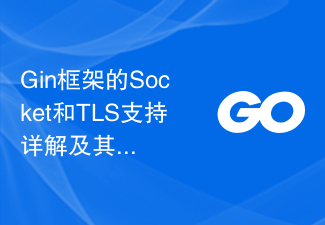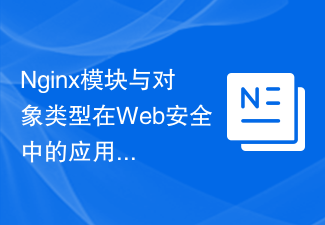With the popularity of the Internet, Web applications have become an indispensable part of our life and work. However, security issues have always been a huge challenge facing Web applications. Web security issues include SQL injection, cross-site scripting attacks, unauthorized access, etc. These security risks may lead to the leakage of confidential data or even complete control of the server. In order to solve these web security problems, we can make use of the web security protection function provided by the Gin framework.
Gin is a lightweight Go language web framework that provides the ability to quickly build high-performance web applications. At the same time, the Gin framework also provides many web security-related functions, the use of which can greatly improve the security of web applications.
- Use HTTPS protocol
HTTPS is an HTTP protocol based on TLS/SSL encrypted communication protocol. It protects the communication process of web applications by using encryption technology of public and private keys to avoid data theft or tampering. If you want to use the HTTPS protocol in your web application, you can automatically redirect HTTP requests to the HTTPS protocol through the middleware provided by the Gin framework.
First, you need to generate a self-signed certificate in the server. Then, use the following code to enable the Gin framework middleware:
func main() {
r := gin.Default()
r.Use(TLSHandler())
...
r.Run(":443")
}
func TLSHandler() gin.HandlerFunc {
return func(c *gin.Context) {
if c.Request.TLS == nil || len(c.Request.TLS.PeerCertificates) == 0 {
loc, err := time.LoadLocation("Asia/Shanghai")
if err != nil {
loc = time.FixedZone("Asia/Shanghai", 8*60*60)
}
c.Redirect(http.StatusMovedPermanently, "https://"+c.Request.Host+c.Request.URL.Path)
return
}
}
}This middleware will check whether the request uses the TLS protocol. If not used, it will redirect to HTTPS protocol via HTTP 301.
- Prevent SQL Injection
SQL injection is an attack method that exploits web application vulnerabilities. An attacker can enter malicious SQL code to tamper with or steal the database. The data. In order to avoid SQL injection attacks, we can use the official support tool GORM of the Gin framework, which provides many security protection measures for database access, such as the use of prepared statements, parameter binding, automatic escaping, etc.
The following is a sample code for the Gin framework to use GORM precompiled statements:
func main() {
db, err := gorm.Open("sqlite3", "test.db")
if err != nil {
panic(err.Error())
}
db.DB().SetMaxIdleConns(10)
db.DB().SetMaxOpenConns(100)
r := gin.Default()
r.GET("/user/:id", func(c *gin.Context) {
var user User
if err := db.Where("id = ?", c.Param("id")).First(&user).Error; err != nil {
c.AbortWithStatus(http.StatusNotFound)
return
}
c.JSON(http.StatusOK, user)
})
r.Run(":8080")
}In the above code, the Gin framework uses precompiled statements when executing SQL queries through the methods provided by GORM, and Bind parameters to the query string. This makes SQL injection attacks more difficult.
- Prevent cross-site scripting attacks
Cross-site scripting attack (XSS) is an attack method in which attackers exploit security vulnerabilities in web applications to inject malicious Code is executed to obtain the user's sensitive information. To prevent XSS attacks, we can use the CSRF middleware provided by the Gin framework.
CSRF middleware will check all HTTP POST requests containing form fields to ensure that they are safe parameters from the Gin framework. If the request does not contain valid security parameters, the CSRF middleware will throw an HTTP 403 status code exception.
The following is a sample code using the Gin framework CSRF middleware:
func main() {
r := gin.Default()
csrf := csrf.New(csrf.Options{
Secret: "krCXcjS0n7vPDS2HaBw00lDWGCQujCn7",
})
r.Use(csrf)
r.POST("/sign", func(c *gin.Context) {
username := c.PostForm("username")
password := c.PostForm("password")
c.JSON(http.StatusOK, gin.H{"message": "登录成功", "username": username, "password": password})
})
r.Run(":8080")
}In the above code, the Gin framework uses the CSRF middleware and sets a key as a security parameter. When a user submits a form request, the CSRF middleware will automatically check and verify the security parameters to ensure that the data is effectively protected during transmission.
- Prevent unauthorized access
Unauthorized access is a method of attack, that is, an attacker exploits security vulnerabilities in web applications to obtain unauthorized access. and then perform malicious operations. To prevent unauthorized access, we can use JWT (JSON Web Token) authentication middleware in Gin framework.
JWT is an authentication protocol based on JSON data structure. It ensures data security and anti-eavesdropping by transmitting security information between the client and the server. When using JWT middleware, we need to use a key to sign all generated tokens. When a user authenticates, the middleware confirms that they are authorized by validating the token.
The following is a sample code using the Gin framework JWT authentication middleware:
func main() {
r := gin.Default()
var db *gorm.DB // 定义数据库
authMiddleware := &jwt.GinJWTMiddleware{
Realm: "test zone",
Key: []byte("krCXcjS0n7vPDS2HaBw00lDWGCQujCn7"),
Timeout: time.Hour,
MaxRefresh: time.Hour,
Authenticator: func(userId string, password string, c *gin.Context) (interface{}, error) {
var user User
if err := db.Where("username = ? AND password = ?", userId, password).First(&user).Error; err != nil {
return nil, fmt.Errorf("用户名或密码错误")
}
return &user, nil
},
Authorizator: func(data interface{}, c *gin.Context) bool {
if v, ok := data.(*User); ok && v.UserName == "admin" {
return true
}
return false
},
Unauthorized: func(c *gin.Context, code int, message string) {
c.JSON(code, gin.H{"code": http.StatusUnauthorized, "message": message})
},
TokenLookup: "header: Authorization, query: token, cookie: jwt",
TokenHeadName: "Bearer",
TimeFunc: time.Now,
}
r.Use(authMiddleware.MiddlewareFunc())
r.POST("/login", authMiddleware.LoginHandler)
r.GET("/admin", authMiddleware.MiddlewareFunc(), func(c *gin.Context) {
c.JSON(http.StatusOK, gin.H{"message": "管理员页面"})
})
r.Run(":8080")
}In the above code, the Gin framework uses the JWT authentication middleware and defines a Verified database. When a user submits valid proof of identity, the JWT middleware calls the "Authenticator" function to verify that they are sufficiently authorized. When the token expires, the JWT middleware automatically refreshes the token using the "MaxRefresh" option.
Summary
Web security issues are one of the main problems faced by Internet applications. In order to ensure the security of web applications, we can use many web security protection plug-ins provided by the Gin framework. Whether it is preventing SQL injection, preventing cross-site scripting attacks, or preventing unauthorized access, the middleware provided by the Gin framework can help us reduce security risks and provide higher user protection in applications.
The above is the detailed content of Using the Gin framework to implement web security protection functions. For more information, please follow other related articles on the PHP Chinese website!
 Gin框架的国际化处理和多语言支持详解Jun 22, 2023 am 10:06 AM
Gin框架的国际化处理和多语言支持详解Jun 22, 2023 am 10:06 AMGin框架是一种轻量级的Web框架,它的特点在于快速和灵活。对于需要支持多语言的应用程序来说,Gin框架可以很方便地进行国际化处理和多语言支持。本文将针对Gin框架的国际化处理和多语言支持进行详细阐述。国际化处理在开发过程中,为了兼顾不同语言的用户,很有必要对应用程序进行国际化处理。简单来讲,国际化处理就是对应用程序的资源文件、代码、文本等内容进行适当修改和
 使用Gin框架实现API网关和认证授权功能Jun 22, 2023 am 08:57 AM
使用Gin框架实现API网关和认证授权功能Jun 22, 2023 am 08:57 AM在现代化互联网架构中,API网关已经成为了重要的组成部分,被广泛应用于企业和云计算的场景中。API网关的主要作用是统一管理和分发多个微服务系统的API接口,提供访问控制和安全保护,同时也能够进行API文档管理、监控和日志记录等方面的工作。为了更好地保障API网关的安全和可扩展性,一些访问控制和认证授权的机制也被加入到了API网关中。这样的机制可以确保用户和服
 Gin框架的日志存储和查询分析详解Jun 22, 2023 am 08:22 AM
Gin框架的日志存储和查询分析详解Jun 22, 2023 am 08:22 AMGin框架是一款轻量级的Web框架,它的优点在于速度快、易用性高、功能强大,因此被越来越多的开发者所喜爱和使用。作为一个Web应用程序,它一定会产生大量的日志信息,为了更好地对这些日志进行存储和查询分析,我们需要对Gin框架的日志功能进行深入了解和应用。一、Gin框架的日志功能Gin框架提供了两种日志记录方式:分别是控制台输出和文件输出。通过设置Gin框架的
 Gin框架的Socket和TLS支持详解及其应用Jun 22, 2023 am 08:27 AM
Gin框架的Socket和TLS支持详解及其应用Jun 22, 2023 am 08:27 AMGin框架是一个轻量级的Web框架,它简单易用,高效快捷,并且支持Socket和TLS协议。本文将对Gin框架的Socket和TLS支持进行详解,并探讨它们在实际项目中的应用。一、Socket支持Socket概述Socket是一种通信协议,它能够在网络上传输数据。Socket是由IP地址和端口号组合而来的,它主要用于进程间的通信,从而实现网络应用的开发。Gi
 Gin框架的虚拟主机和域名绑定功能详解Jun 22, 2023 am 09:10 AM
Gin框架的虚拟主机和域名绑定功能详解Jun 22, 2023 am 09:10 AMGin框架是一个轻量级的Web框架,它提供了快速构建Web应用程序所需的基本功能。Gin框架具有灵活、高效、可扩展的特点,所以被广泛应用于互联网领域。其中,Gin框架的虚拟主机和域名绑定功能,是其它Web框架所不具备的重要特性,本文将对该功能进行详细介绍。一、什么是虚拟主机?虚拟主机是在一台物理主机上创建多个独立的、互相隔离的虚拟主机,每个虚拟主机都有自己独
 Nginx模块与对象类型在Web安全中的应用Jun 10, 2023 am 09:33 AM
Nginx模块与对象类型在Web安全中的应用Jun 10, 2023 am 09:33 AM随着互联网和Web应用的发展,网络安全已经成为了一个重要的话题。Web应用程序安全问题的风险日益增加,使安全成为了开发人员和网站管理员的首要任务。在这个环境下,Nginx模块和对象类型在Web安全中扮演着至关重要的角色。Nginx是一个高性能的Web服务器和反向代理服务器。它可以同时处理几千个并发连接,同时拥有占用资源少、高稳定性和可扩展性等优点。Nginx
 使用Gin框架实现任务队列和消息队列功能Jun 22, 2023 pm 12:58 PM
使用Gin框架实现任务队列和消息队列功能Jun 22, 2023 pm 12:58 PMGin是一个基于Go语言的Web框架,被广泛应用于Web开发领域。但是,除了在Web开发中,Gin框架还可以用来实现其他功能,比如任务队列和消息队列。任务队列和消息队列是现代分布式系统中常见的组件,用于异步处理数据和消息。这些队列可以用于削峰填谷、异步处理大量数据等场景,其中任务队列更加注重工作流程,将每个任务按照一定的流程顺序执行;而消息队列则更注重异步通
 使用Gin框架实现数据同步和备份功能Jun 22, 2023 am 09:40 AM
使用Gin框架实现数据同步和备份功能Jun 22, 2023 am 09:40 AM随着数据量不断增大,在数据管理和备份方面,已经变得越来越重要。而在现代的互联网应用中,使用Gin框架实现数据同步和备份功能已经成为一个重要的部分。Gin框架是一个轻量级的Go语言Web框架,采用了MVC(模型-视图-控制器)的设计模式,旨在简化Web应用程序的开发。使用Gin框架开发的Web应用可以快速高效地处理HTTP请求和响应,并且具有高度的可扩展性和可


Hot AI Tools

Undresser.AI Undress
AI-powered app for creating realistic nude photos

AI Clothes Remover
Online AI tool for removing clothes from photos.

Undress AI Tool
Undress images for free

Clothoff.io
AI clothes remover

AI Hentai Generator
Generate AI Hentai for free.

Hot Article

Hot Tools

SublimeText3 Linux new version
SublimeText3 Linux latest version

EditPlus Chinese cracked version
Small size, syntax highlighting, does not support code prompt function

SublimeText3 Chinese version
Chinese version, very easy to use

Notepad++7.3.1
Easy-to-use and free code editor

Dreamweaver Mac version
Visual web development tools






